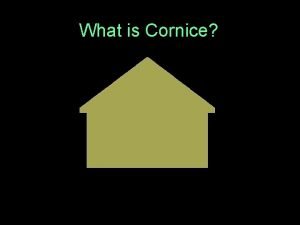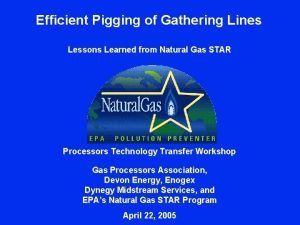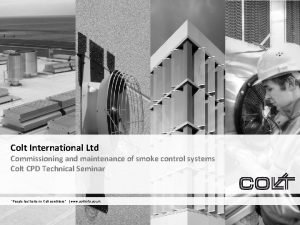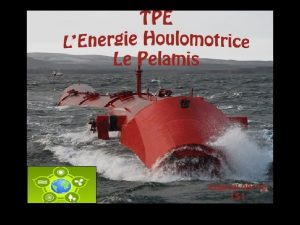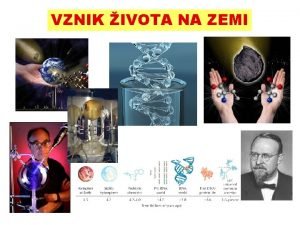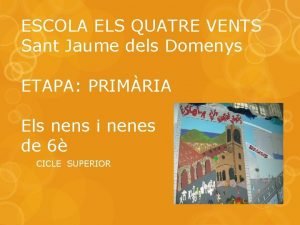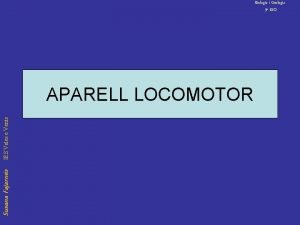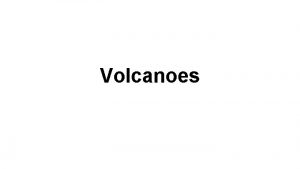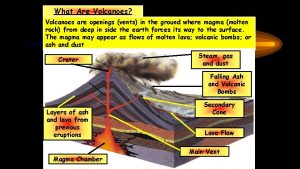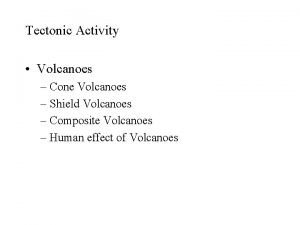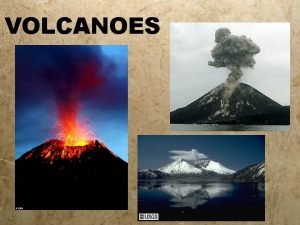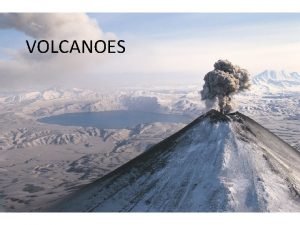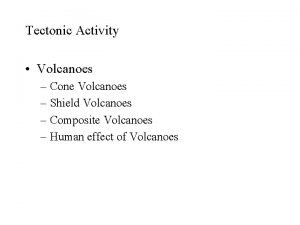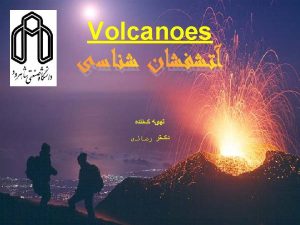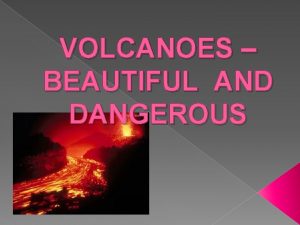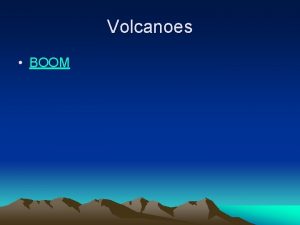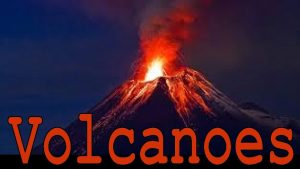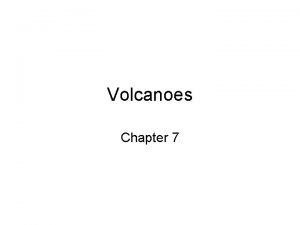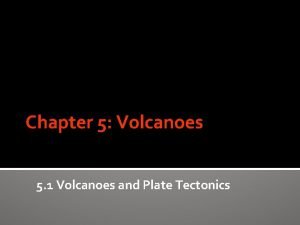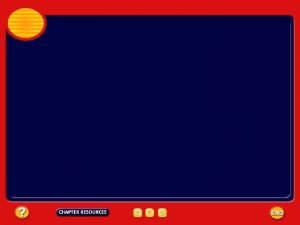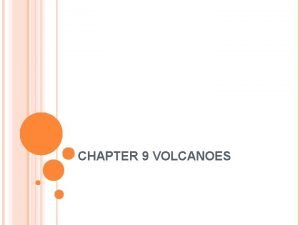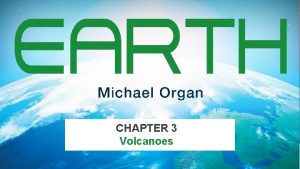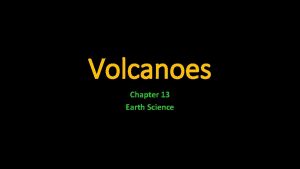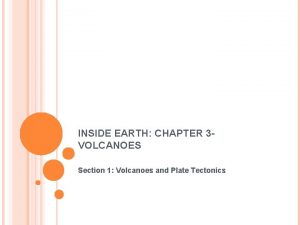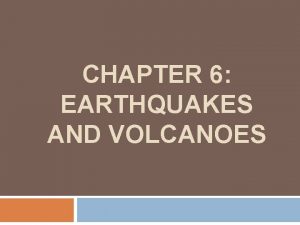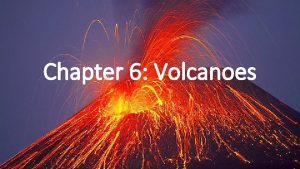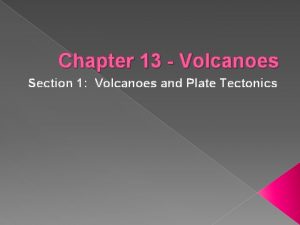Chapter 17 VOLCANOES Volcanoes Volcanoes vents in the






















- Slides: 22

Chapter 17 VOLCANOES

Volcanoes �Volcanoes - vents in the Earth’s surface where magma and gas arise. �Lava – Magma on top of the Earth’s surface.

What is inside a volcano? �Magma Chamber- the body of molten rock that feeds the volcano. �Vent – an opening at the surface of the Earth through which volcanic material passes.

What makes up Magma? �The make-up (composition) of the magma affects how violent an eruption is. �Lots of Water and Magma = Explosive. - When magma quickly moves to the surface, the water turns to gas. The gas expands quickly. �Magma and Silica = Explosive. - it is very thick and it clogs the vents, which builds pressure.

What Erupts from a volcano? �Lava �Pyroclastic material – hard magma

Types of Lava �Aa – fast pouring lava that forms a brittle, jagged crust.

Types of Lava �Pahoehoe- slowly flowing lava that has a glassy surface with rounded wrinkles.

Types of Lava �Pillow lava – forms when lava erupts underwater.

Types of Lava �Blocky lava – forms near the vents and looks like jumbled heaps of sharp-edged chunks.

Types of Pyroclastic Material �Volcanic bomb – large blobs of magma that harden in the air.

Types of Pyroclastic Material �Volcanic blocks– solid rock.

Types of Pyroclastic Material �Lapilli- means “little stones. ” Bits of hardened magma.

Types of Pyroclastic Material �Volcanic ash – forms when gases expand rapidly. (The most common type. )

Pyroclastic Flows � These are produced when enormous amounts of hot ash, dust, and gases are ejected from a volcano. � This cloud can move more than 124 mph � The temperature can be more than 1, 292 degrees F.

Types of volcanoes �Shield volcanoes – made of layers and layers of lava. Spread out over a large area. Sides are not steep

Types of volcanoes �Cinder Cone Volcanoes – made of pyroclastic material. Have steeps sides.

Types of volcanoes �Composite Volcanoes - Most common type. Made from alternating layers of pyroclastic material and lava. Broad bases and steep sides.

Volcanic Landforms �Craters – a funnel-shaped pit near the top of the central vent of a volcano.

Volcanic Landforms �Caldera – a large, semicircular depression that forms when the magma chamber below a volcano partially empties and causes the ground below to sink.

Volcanic Landforms �Lava Plateau – wide flat areas of land that result from lava that spread out over a large area.

Where Volcanoes Form �Most form near tectonic plate boundaries. �Magma is able to form and move up to the Earth’s surface. �Some form over “hot spots; ” areas that have a lot of magma under them, but are not near a plate boundary.

Chapter Review �Page 470 -471 �Don’t write the questions. �Do not do #17
 Boxed cornice
Boxed cornice Nom dels vents a catalunya
Nom dels vents a catalunya Rondeau xxxix
Rondeau xxxix Bresenham vents
Bresenham vents Smoke control system maintenance
Smoke control system maintenance Les vents
Les vents Mullerova rohatka
Mullerova rohatka Escola sant jaume dels domenys
Escola sant jaume dels domenys Articulacions fixes
Articulacions fixes Chapter 8 earthquakes and volcanoes
Chapter 8 earthquakes and volcanoes Hình ảnh bộ gõ cơ thể búng tay
Hình ảnh bộ gõ cơ thể búng tay Ng-html
Ng-html Bổ thể
Bổ thể Tỉ lệ cơ thể trẻ em
Tỉ lệ cơ thể trẻ em Voi kéo gỗ như thế nào
Voi kéo gỗ như thế nào Tư thế worm breton là gì
Tư thế worm breton là gì Bài hát chúa yêu trần thế alleluia
Bài hát chúa yêu trần thế alleluia Môn thể thao bắt đầu bằng từ đua
Môn thể thao bắt đầu bằng từ đua Thế nào là hệ số cao nhất
Thế nào là hệ số cao nhất Các châu lục và đại dương trên thế giới
Các châu lục và đại dương trên thế giới Công thức tính độ biến thiên đông lượng
Công thức tính độ biến thiên đông lượng Trời xanh đây là của chúng ta thể thơ
Trời xanh đây là của chúng ta thể thơ Mật thư anh em như thể tay chân
Mật thư anh em như thể tay chân
